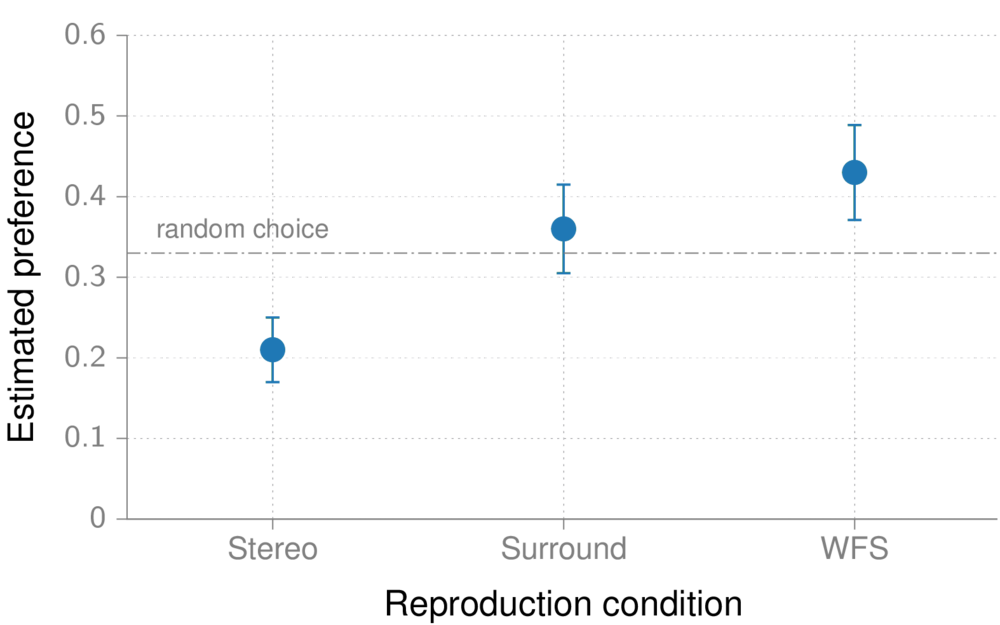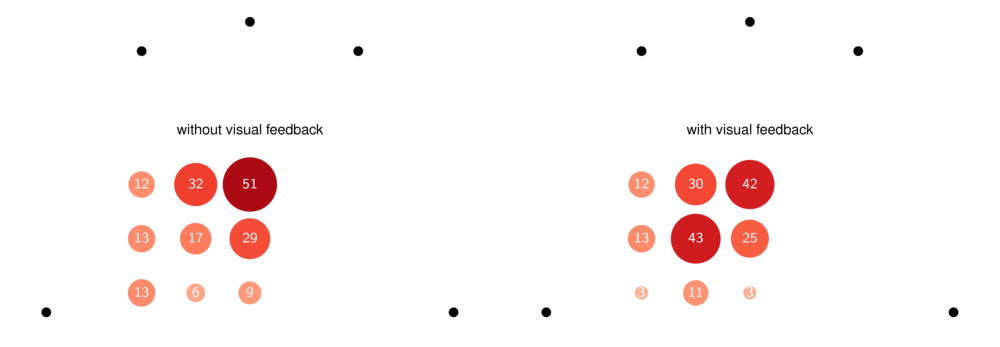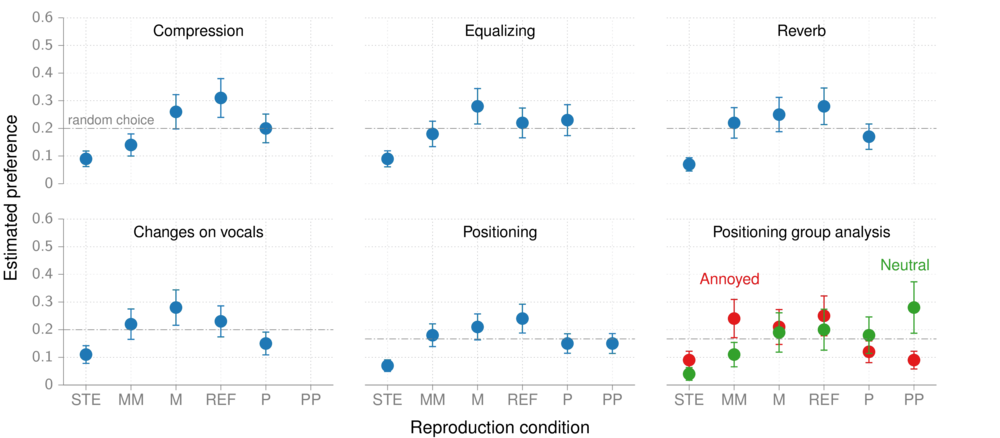Quality ratings¶
- 2014-04-01: Scene related sound quality
- 2015-11-01: Listening preference of popular music presented by WFS, surround, and stereo
- 2016-03-01: Listening position preference for different 5.0 reproductions
- 2016-06-01: Listening preference of different mixes of one popular music song presented by WFS (binaural simulation)
- 2016-11-18: Listening preference of different mixes of one popular music song presented by WFS
2015-11-01: Listening preference of popular music presented by WFS, surround, and stereo¶
 Published by members of the Two!Ears consortium
Published by members of the Two!Ears consortium
Digital Object Identifier¶
- Stimuli: doi: 10.14279/depositonce-5173
- Results: doi: 10.5281/zenodo.164433
License¶
Description¶

Fig. 55 Estimated preference of the different reproduction systems
averaged over all listeners and musical pieces. The preference was estimated
with a Bradley-Terry-Luce model. The bars denote the corresponding 95%
confidence interval. (PDF version)
We did a paired comparison preference test where listeners rated their listening preference for four different pop musical pieces presented by WFS, stereo or surround. The musical pieces were all mixed by the same person in order to try to minimize the influence of the mix on the ratings, but still trying to get the best out of every system, see [Hold2016a] for details. As this experiment was performed with real loudspeakers, there are no BRS files available with this experiment, but if you like to run a binaural model on the stimuli you can try the BRS files from 2016-06-01: Listening preference of different mixes of one popular music song presented by WFS (binaural simulation) which provide a anechoic binaural simulation of the loudspeaker array setup used in this experiment.
Files¶
experiments/2015-11-01_wfs_stereo_comparison/results/*
experiments/2015-11-01_wfs_stereo_comparison/stimuli/brew-stereo.wav
experiments/2015-11-01_wfs_stereo_comparison/stimuli/brew-surround.wav
experiments/2015-11-01_wfs_stereo_comparison/stimuli/brew-wfs.wav
experiments/2015-11-01_wfs_stereo_comparison/stimuli/brew2-stereo.wav
experiments/2015-11-01_wfs_stereo_comparison/stimuli/brew2-surround.wav
experiments/2015-11-01_wfs_stereo_comparison/stimuli/brew2-wfs.wav
experiments/2015-11-01_wfs_stereo_comparison/stimuli/lighthouse-stereo.wav
experiments/2015-11-01_wfs_stereo_comparison/stimuli/lighthouse-surround.wav
experiments/2015-11-01_wfs_stereo_comparison/stimuli/lighthouse-wfs.wav
experiments/2015-11-01_wfs_stereo_comparison/stimuli/lighthouse2-stereo.wav
experiments/2015-11-01_wfs_stereo_comparison/stimuli/lighthouse2-surround.wav
experiments/2015-11-01_wfs_stereo_comparison/stimuli/lighthouse2-wfs.wav
experiments/2015-11-01_wfs_stereo_comparison/stimuli/sister-stereo.wav
experiments/2015-11-01_wfs_stereo_comparison/stimuli/sister-surround.wav
experiments/2015-11-01_wfs_stereo_comparison/stimuli/sister-wfs.wav
experiments/2015-11-01_wfs_stereo_comparison/stimuli/toynbee-stereo.wav
experiments/2015-11-01_wfs_stereo_comparison/stimuli/toynbee-surround.wav
experiments/2015-11-01_wfs_stereo_comparison/stimuli/toynbee-wfs.wav
| [Hold2016a] | (1, 2, 3) Hold, C., Wierstorf, H., Raake, A. (2016), “The Difference Between Stereophony and Wave Field Synthesis in the Context of Popular Music,” 140th AES Convention, Paper 9533 |
2016-03-01: Listening position preference for different 5.0 reproductions¶
 Published by members of the Two!Ears consortium
Published by members of the Two!Ears consortium
Digital Object Identifier¶
Description¶

Fig. 56 Number of chosen preferred positons summed over all listeners and recording
techniques. On the left side the results without visual feedback and on the
right with visual feedback about the actual listening position are shown.
(PDF version)
We conducted an experiment on the preferred listening position in a 5.0 surround setup. The experiment was performed in the studio like room Calypso in the Telefunken building of the TU Berlin. The experiment employed dynamic binaural synthesis in order to allow instantaneous switching between positions during listening. To accomplish this BRIRs were recorded before at nine different positions, see TU Berlin, room Calypso, 5.0 surround setup for different listening positions. 26 test participants rated their preferred listening position out of the 9 positions for every recording technique. They did this first without visual feedback using a GUI that only showed nine buttons where the stimuli were randomly assigned to. In a second run they had a GUI showing a actual sketch of the listening setup, similar to the sketch shown in Table 48.
Note
The BRIRs used in this experiment were not the one available under 10.5281/zenodo.160761, but an earlier version available under 10.5281/zenodo.49691. That earlier version had an error in the metadata of the stored SOFA files, resulting in the fact that the listeners were not looking towards the front at all listening positions, but facing always towards the center loudspeaker.
As music material seven different simultaneously recordings of the piece “Maurerische Trauermusik K.477” of W. A. Mozart were used. The recordings differed in the applied recording technique, which are listed in Table 45 and were done at ORF (Austrian Broadcast, Vienna) and the piece was played by the Radio Symphony Orchestra Vienna. For more details on the applied microphones and for downloading all recordings have a look at [Wittek2015].
Fig. 56 summarizes the results across all listeners
and recording techniques, showing only differences between with and without
visual feedback. The results for the different recording techniques are
summarized in this PDF.
For more details on the experiment have a look at [Schultze2016].
| Abbreviation | Recording technique |
| Rec. 80 | Stereo + C + NHK |
| Rec. 81 | Decca-Tree + NHK |
| Rec. 82 | OCT + NHK |
| Rec. 83 | INA5 (Brauner ASM5) |
| Rec. 84 | Schoeps KFM 360 + DSP-4 KFM 360 |
| Rec. 85 | OCT-Surround |
| Rec. 86 | Soundfield MKV + SP 451 |
Files¶
The experiment was performed with dynamic binaural synthesis. The employed BRS files are available under:
experiments/2016-03-01_sweet_spot/brs/
The actual stimuli were extracted from the DVD available for download at [Wittek2015] and are stored in the database as wav files under:
experiments/2016-03-01_sweet_spot/stimuli/
The results of the single listeners are available under:
experiments/2016-03-01_sweet_spot/results/no_visual_feedback/
experiments/2016-03-01_sweet_spot/results/visual_feedback/
The analysis, resulting in Fig. 56 is available under:
experiments/2016-03-01_sweet_spot/analysis/
| [Schultze2016] | Schultze, A. (2016), “Der Sweet Spot in 5.0 Wiedergabesystemen in Abhängigkeit des Aufnahmeverfahrens und des visuellen Eindrucks des Zuhörers,” bachelor thesis, Technische Universität Berlin |
| [Wittek2015] | (1, 2) Wittek, H. (2015), “ORF Surround sound techniques, 2002,” http://www.hauptmikrofon.de/stereo-3d/orf-surround-techniques, last access: 2016/10/21 |
2016-06-01: Listening preference of different mixes of one popular music song presented by WFS (binaural simulation)¶
 Published by members of the Two!Ears consortium
Published by members of the Two!Ears consortium
Digital Object Identifier¶
- Stimuli: doi: 10.5281/zenodo.61000
- Results: doi: 10.5281/zenodo.162161
Description¶

Fig. 57 Estimated preferences of the different mixes of a piece of pop music for
WFS. The conditions are stereo (STE), WFS reference (REF), both from
a former listening test, WFS
with mixing parameter switched off (MM), WFS with decreased processing of
the specified mixing parameter (M), WFS with increased processing (P), and
WFS with further increased processing (PP). The preference was estimated
with a Bradley-Terry-Luce model. The bars denote the corresponding 95%
confidence interval. (PDF version)
We did a paired comparison preference test where listeners rated their listening preference for a pop musical pieces presented by WFS or stereo. For WFS four to five different mixes of the same song were presented for one run of the experiment. Those mixes were variations along one of the following mixing parameters: “compression”, “equalizing”, “reverb”, “changes of reverb, equalizing and compression to the vocals alone”, “positioning of musical foreground elements”. The musical pieces were all mixed by the same person, that also mixed the stereo and WFS reference condition, compare [Hold2016a]. The results for the “positioning of musical foreground elements” are discussed in more detail in [Hold2016b].
Files¶
The experiment was performed with dynamic binaural synthesis. The BRS files for the 56-channel circular loudspeaker array are available under:
experiments/2016-06-01_wfs_mixing_quality/brs/
The actual stimuli for the different mixing conditions are available as wav file, containing the driving signals for the loudspeakers. The stereo file is available as a two channel signal, the WFS signals are stored in a 64-channel wav file, where the first 56 channel are the driving signals for the loudspeakers:
experiments/2016-06-01_wfs_mixing_quality/stimuli/
The single preference ratings of the 41 test participants and the results of the survey conducted after the experiment are available under:
experiments/2016-06-01_wfs_mixing_quality/results/
The data analysis scripts and results, that calculates the preference values shown in Fig. 57 are available under:
experiments/2016-06-01_wfs_mixing_quality/analysis/
| [Hold2016b] | Hold, C., Nagel, L., Wierstorf, H., Raake A. (2016), “Positioning of Musical Foreground Parts in Surrounding Sound Stages,” AES International Conference on Audio for Virtual and Augmented Reality, Paper 7-2 |
2016-11-18: Listening preference of different mixes of one popular music song presented by WFS¶
 Published by members of the Two!Ears consortium
Published by members of the Two!Ears consortium
Digital Object Identifier¶
- Stimuli: doi: 10.5281/zenodo.61000
- Results: doi: 10.5281/zenodo.167331
Description¶

Fig. 58 Estimated preferences of the different mixes of a piece of pop music for
WFS. The conditions are stereo (STE), surround (5.1) WFS reference (REF), both from
a former listening test, WFS
with mixing parameter switched off (MM), WFS with decreased processing of
the specified mixing parameter (M), WFS with increased processing (P), and
WFS with further increased processing (PP). The preference was estimated
with a Bradley-Terry-Luce model. The bars denote the corresponding 95%
confidence interval. (PDF version)
We did a paired comparison preference test where listeners rated their listening preference for a pop musical pieces presented by WFS or stereo. For WFS four to five different mixes of the same song were presented for one run of the experiment. Those mixes were variations along one of the following mixing parameters: “compression”, “equalizing”, “reverb”, “changes of reverb, equalizing and compression to the vocals alone”, “positioning of musical foreground elements”. The musical pieces were all mixed by the same person, that also mixed the stereo and WFS reference condition, compare [Hold2016a]. This experiment is very similar to an earlier one with the main difference that the earlier one used binaural synthesis to present the stimuli, whereby here we have used real loudspeaker setups.
Files¶
The actual stimuli for the different mixing conditions are available as wav file, containing the driving signals for the loudspeakers. The stereo file is available as a two channel signal, the WFS signals are stored in a 64-channel wav file, where the first 56 channel are the driving signals for the loudspeakers:
experiments/2016-11-18_wfs_mixing_quality/stimuli/
The single preference ratings of the 41 test participants and the results of the survey conducted after the experiment are available under:
experiments/2016-11-18_wfs_mixing_quality/results/
The data analysis scripts and results, that calculates the preference values shown in Fig. 58 are available under:
experiments/2016-11-18_wfs_mixing_quality/analysis/
